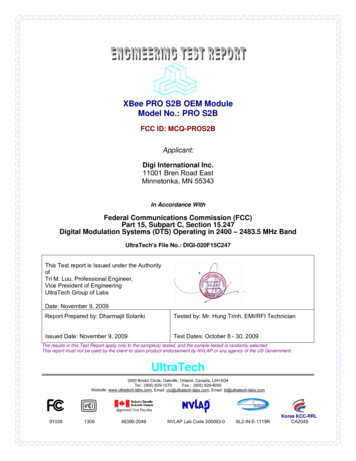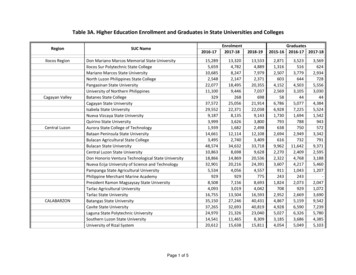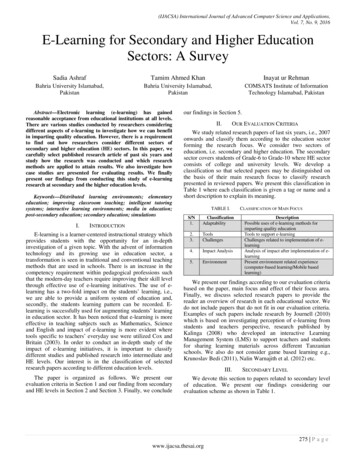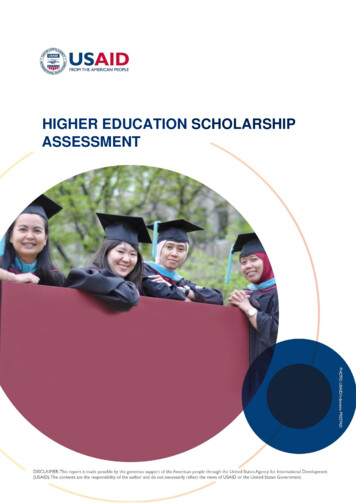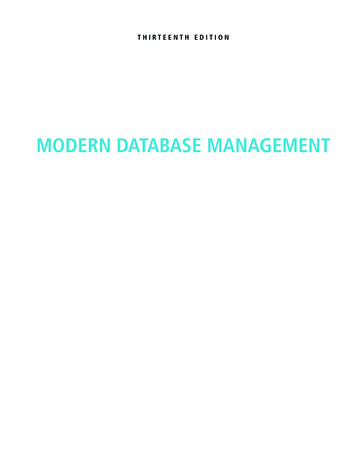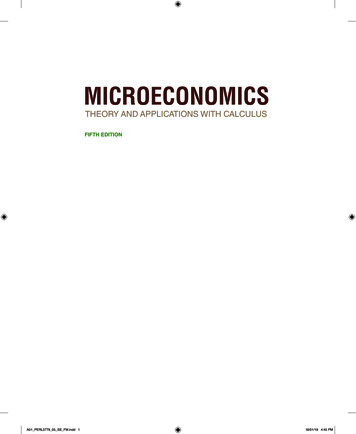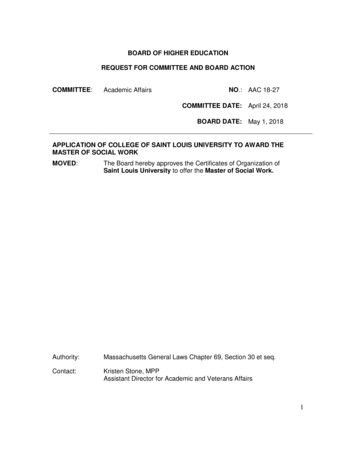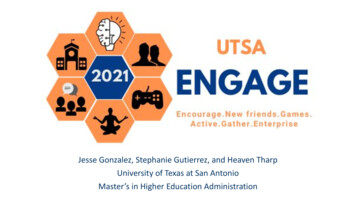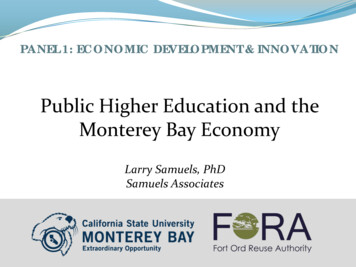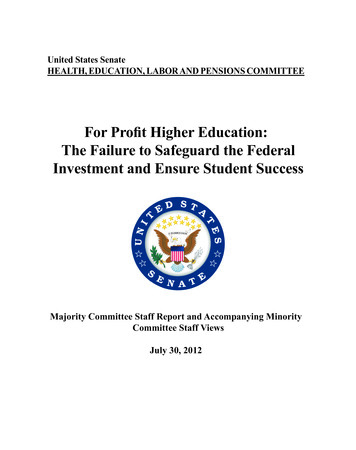
Transcription
United States SenateHEALTH, EDUCATION, LABOR AND PENSIONS COMMITTEEFor Profit Higher Education:The Failure to Safeguard the FederalInvestment and Ensure Student SuccessMajority Committee Staff Report and Accompanying MinorityCommittee Staff ViewsJuly 30, 2012
ContentsExecutive Summary . 1Introduction . 12Institutions Examined . 20Publicly Traded Companies . 20Private Equity Owned Companies . 22Closely Held Corporations. 23The Federal Investment and the Changing Sector. 24Increasing Federal Investment . 24Increasing Reliance on Federal Dollars . 24Pell Grant Funds . 25Military Education Benefits . 27Growth and Change in the For-Profit Sector . 30Why Are Companies that Own For-Profit Colleges Financially Successful? . 35High Cost of Attendance . 35Higher Tuition at For-Profit Colleges. 35Tuition Decisions Made To Maximize Revenue . 37Executives’ Recognition That Higher Tuition Leads to More Withdrawals . 43Concealing the Cost of Tuition. 44Aggressive and Deceptive Recruiting . 46Recruiters Operate in a Boiler-Room Sales Atmosphere . 49Misleading and Deceptive Tactics . 53Techniques to Close a Sale . 59Military Focused Recruiting. 68How Are Students Performing? . 72Inadequate Public Data for Meaningful Oversight . 72Low Student Retention . 73Worst Performing Programs . 74Online Student Retention. 75Publicly Traded Company Student Retention . 77Heavy “Churn” . 77The Costs of Withdrawal . 80Why Do Many Students Fail to Complete For-Profit Programs?. 81Spending Choices of For-Profit Education Companies. 81Marketing, Recruiting, and Profit . 81Executive Compensation . 84Instructional Spending . 86
Student Success is Divorced From Company Success . 88Academic Quality . 89Part-time Faculty . 94Student Services . 95Career Placement Services . 98Incentives for Career Services Staff . 100Programmatic Accreditation and Licensure. 102What Is Programmatic Accreditation. 102Students Are Not Informed About Programmatic Accreditation . 103A Case Study of Sanford-Brown’s Disclosures for Popular Program Areas . 104A Comparison of Multiple Schools’ Disclosures for Two Smaller Degree Programs. 109Lower Licensing Exam Pass Rates .110Conclusion .111What Are the Consequences for Students? . 112High Debt .112What Default Means for Students and Society .118Higher Unemployment . 120Credentials in Lower Demand Careers . 121Why is This Happening?. 122Accreditation . 122Structural Defects in the Accrediting Process . 123Accreditors Are Not Equipped to Properly Regulate Large For-Profit Institutions . 125Higher Learning Commission of the North Central Association of Colleges and Schools . 126Federal Law and Regulation . 132Evasion of Regulatory Requirements . 13690/10 Strategies . 137Student Loan Default Rate Management And Manipulation . 150Return of Title IV Funds . 159Job Placement Rate Manipulation . 160The Consequences of Inaction. 167What Needs to Be Done? . 169Enhanced Transparency . 169Stronger Oversight . 171Meaningful Protections. 173Minority Committee Staff Views . 177Selected Appendices . A3-1
In accordance with Rule XXV of the Standing Rules of the Senate, the U.S. Senate Committeeon Health, Education, Labor, and Pensions (the committee) holds legislative jurisdiction over all proposed legislation, messages, petitions, memorials, and other matters relating to education and studentloans and grants. Proprietary schools and institutions of higher education, henceforth referred to asfor-profit colleges, fall under this jurisdiction both as academic institutions and as eligible recipientsof Federal loans and grants provided through Title IV of the Higher Education Act. Senate rules alsoprovide that the committee shall study and review, on a comprehensive basis, matters relating to education. In April 2010, under the leadership of Chairman Tom Harkin, the committee initiated an oversightinvestigation into the proprietary sector of higher education. The majority staff offers this report to thecommittee with accompanying minority staff views.
FĔė-PėĔċĎę HĎČčĊė EĉĚĈĆęĎĔē:The Failure to Safeguard the Federal Investment and Ensure StudentSuccessBetween June 2010 and July 2012, Senate HELP Committee Chairman Tom Harkin conductedan in-depth oversight investigation focusing exclusively on the for-profit sector of higher education. Theinvestigation was undertaken to better understand the enormous growth in both the number of studentsattending for-profit colleges and the Federal student aid investment that taxpayers are making in thecolleges. This growth has occurred as for-profit colleges have increasingly been acquired or created bypublicly traded companies and private equity firms that are closely tracked by analysts and by investorsseeking quick returns. Unlike traditional non-profit and public colleges, virtually all of the revenues offor-profit colleges come directly from taxpayers, and significant portions of their expenses are dedicatedto marketing and recruiting and to profit. The key findings of the investigation are summarized below.
Executive Summary: A 2-year investigation by the Senate Committee on Health, Education, Labor, and Pensions demonstrated that Federal taxpayers are investing billions of dollars a year, 32 billion in the most recentyear, in companies that operate for-profit colleges. Yet, more than half of the students who enrolledin in those colleges in 2008-9 left without a degree or diploma within a median of 4 months. For-profit colleges are owned and operated by businesses. Like any business, they are ultimatelyaccountable by law for the returns they produce for shareholders. While small independent forprofit colleges have a long history, by 2009, at least 76 percent of students attending for-profitcolleges were enrolled in a college owned by either a company traded on a major stock exchangeor a college owned by a private equity firm. The financial performance of these companies isclosely tracked by analysts and by investors. Congress has failed to counterbalance investor demands for increased financial returns withrequirements that hold companies accountable to taxpayers for providing quality education, support, and outcomes. Federal law and regulations currently do not align the incentives of for-profitcolleges so that the colleges succeed financially when students succeed. For-profit colleges have an important role to play in higher education. The existing capacity ofnon-profit and public higher education is insufficient to satisfy the growing demand for highereducation, particularly in an era of drastic cutbacks in State funding for higher education. Meanwhile, there has been an enormous growth in non-traditional students—those who either delayedcollege, attend part-time or work full-time while enrolled, are independent of their parents, orhave dependents other than a spouse. This trend has created a “new American majority” of nontraditional students. In theory, for-profit colleges should be well-equipped to meet the needs of non-traditional students. They offer the convenience of nearby campus and online locations, a structured approachto coursework and the flexibility to stop and start classes quickly and easily. These innovationshave made attending college a viable option for many working adults, and have proven successful for hundreds of thousands of people who might not otherwise have obtained degrees. But for-profit colleges also ask students with modest financial resources to take a big risk byenrolling in high-tuition schools. As a result of high tuition, students must take on significant student loan debt to attend school. When students withdraw, as hundreds of thousands do each year,they are left with high monthly payments but without a commensurate increase in earning powerfrom new training and skills. Many for-profit colleges fail to make the necessary investments in student support services thathave been shown to help students succeed in school and afterwards, a deficiency that undoubt-1-
edly contributes to high withdrawal rates. In 2010, the for-profit colleges examined employed35,202 recruiters compared with 3,512 career services staff and 12,452 support services staff,more than two and a half recruiters for each support services employee. This may help to explain why more than half a million students who enrolled in 2008-9 left without a degree or Certificate by mid-2010. Among 2-year Associate degree-seekers, 63 percent ofstudents departed without a degree. The vast majority of the students left with student loan debt that may follow them throughouttheir lives, and can create a financial burden that is extremely difficult, and sometimes impossible, to escape. During the same period, the companies examined spent 4.2 billion on marketing and recruiting,or 22.7 percent of all revenue. Publicly traded companies operating for-profit colleges had anaverage profit margin of 19.7 percent, generated a total of 3.2 billion in pre-tax profit and paidan average of 7.3 million to their chief executive officers in 2009. In the absence of significant reforms that align the incentives of for-profit colleges to ensurecolleges succeed financially only when students also succeed, and ensure that taxpayer dollarsare used to further the educational mission of the colleges, the sector will continue to turn outhundreds of thousands of students with debt but no degree, and taxpayers will see little return ontheir investment.The Federal Investment and the Changing Sector In the 1990s, two-thirds of for-profit colleges enrolled students in training programs lasting lessthan 1 year. The sector was primarily composed of small trade schools that awarded Certificatesand diplomas in fields like air-conditioning repair, cosmetology, and truck driving. While Certificate and diploma offerings have continued to grow, growth in degree programs has been moresignificant. Between 2004 and 2010, the number of Associate degrees awarded by for-profit colleges increased 77 percent and the number of Bachelor’s degrees awarded increased 136 percent. For profit colleges are rapidly increasing their reliance on taxpayer dollars. In 2009-10, the sectorreceived 32 billion, 25 percent of the total Department of Education student aid program funds. Pell grants flowing to for-profit colleges increased at twice the rate of the program as a whole,increasing from 1.1 billion in the 2000-1 school year to 7.5 billion in the 2009-10 school year. Among the companies examined by the committee, the share of revenues received from Department of Education Federal student aid programs increased more than 10 percent, from 68.7 in2006 to 81.9 percent in 2010.-2-
Committee staff estimates that in 2009 when all sources of Federal taxpayer funds, includingmilitary and veterans’ benefits, are included, the 15 publicly traded for-profit education companies received 86 percent of revenues from taxpayers. For-profit colleges also receive the largest share of military educational benefit programs: 37percent of post-9/11 GI bill benefits and 50 percent of Department of Defense Tuition Assistancebenefits flowed to for-profit colleges in the most recent period. Because of the cost of the programshowever, they trained far fewer students than public colleges. Eight of the top 10 recipients of Department of Veterans Affairs post-9/11 GI bill funds are for-profit education companies.Why Are Companies that Own For-Profit Colleges Financially SuccessfulHigh Cost of Programs: Most for-profit colleges charge higher tuition than comparable programs at community collegesand flagship State public universities.o Bachelor’s degree programs averaged 20 percent more than the cost of analogous programsat flagship public universities.o Associate degree programs averaged four times the cost of degree programs at comparablecommunity colleges.o Certificate programs similarly averaged four and a half times the cost of such programs atcomparable community colleges. The for-profit education companies examined rarely set tuition below available Federal student aid. Internal company documents provide examples of tuition increases being implemented to satisfycompany profit goals, that have little connection to increases in academic and instruction expenses, and demonstrate that for-profit education companies sometimes train employees to evadedirectly answering student questions about the cost of tuition and fees.Aggressive and Sometimes Misleading and Deceptive Recruiting Practices: Documents indicate that the recruiting process at for-profit education companies is essentially asales process. Investors’ demand for revenue growth is satisfied by enrolling a steady stream ofnew student enrollees or “starts.” During the period examined, at many companies the performance of each person in the admissions chain, from CEO to newly-hired junior recruiters, wasrated at least in part based on the number of students enrolled.-3-
The committee found that the 30 for-profit education companies examined employed 35,202recruiters, or about one recruiter for every 53 students attending a for-profit college in 2010. Documents demonstrate that in order to achieve company enrollment goals, recruiting managers at some companies created a boiler-room atmosphere, in which hitting an enrollment quotawas the recruiters’ highest priority. Recruiters who failed to bring in enough students were putthrough disciplinary processes and sometimes terminated. Before a ban on incentive compensation was re-instituted in mid-2011, recruiters’ salaries at many for-profit colleges were tightlytied to enrolling a certain number of new students. Internal documents, interviews with former employees, and Government Accountability Office (GAO) undercover recordings demonstrate that many companies used tactics that misledprospective students with regard
college, attend part-time or work full-time while enrolled, are independent of their parents, or have dependents other than a spouse. This trend has created a “new American majority” of non-traditional students. In theory, for-profi
